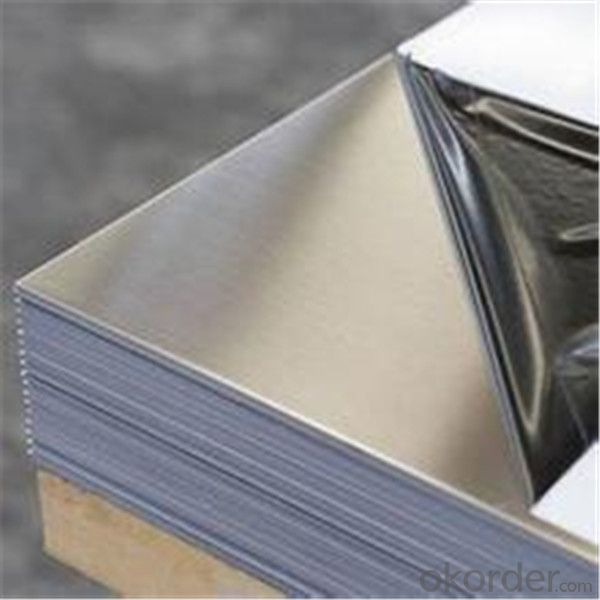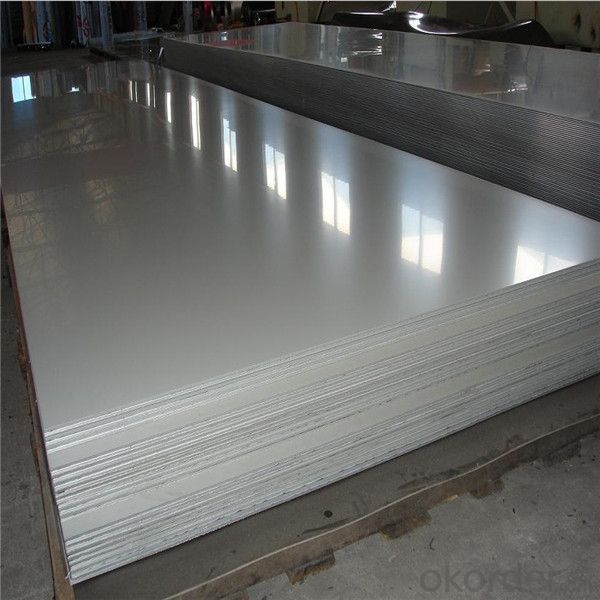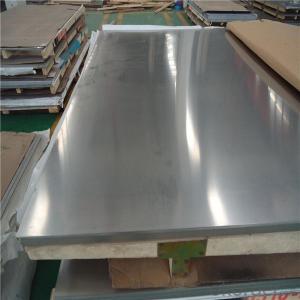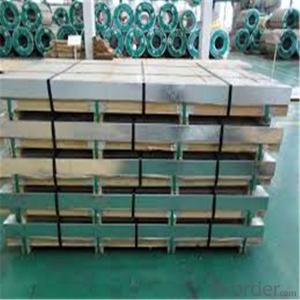410 430 Color Coating Stainless Steel Sheet
- Loading Port:
- Shanghai
- Payment Terms:
- TT OR LC
- Min Order Qty:
- 1 m.t.
- Supply Capability:
- 5000 m.t./month
OKorder Service Pledge
OKorder Financial Service
You Might Also Like
Item specifice
410 430 Color Coating Stainless Steel Sheet
OUR STRENGTH
MANUFACTURER
SPECIALIZING IN PROCESSING 400 SERIES STAINLESS STEEL
WELL-TRAINED AND EXPERIENCED STAFFS
ABLE TO ANSWER ALL YOUR ENQUIRIES IN FLUENT ENGLISH.
SPANISH ENQUIRIES CAN BE WELL UNDESTAND AND REPLIED.
SPECIFICATIONS ( 410 430 Color Coating Stainless Steel Sheet )
Material | Ferrite stainless steel, magnetic. |
Standard | AISI, ASTM, EN, GB, DIN, JIS |
Grade | 409 / 410 / 430 |
Technology | Cold Rolled |
Form | Strips / Coils |
Thickness | 0.17mm - 2.0mm (tolerances ±0.02mm) |
Width | 10.0mm - 850mm (tolerances ±6.00mm) |
Coil ID | Φ500mm-600mm |
Coil OD | Φ2100mm max. |
The sizes or thicknesses of stainless steel coil can be customized, if you need additional information, please don’t hesitate to contact us at any time. | |
CHEMICAL COMPOPSITION ( 410 430 Color Coating Stainless Steel Sheet )
GRADE | C | Mn | Si | P | S | Cr | Mo | Ni | N | |
410 | min. | - | - | - | - | - | 11.50 | - | 0.75 | - |
max. | 0.15 | 1.00 | 1.00 | 0.04 | 0.03 | 13.50 | ||||
430 | min. | - | - | - | - | - | 16.00 | - | - | - |
max. | 0.12 | 1.00 | 1.00 | 0.04 | 0.03 | 18.00 | 0.75 | |||


SERVICE ( 410 430 Color Coating Stainless Steel Sheet )
Processing | Pickling / Straighten / Flatten / Leveling |
Form | Rolling Coils / Cutting Sheets / Stamping Circles |
Edge | Mill Edge / Slitting edge |
Annealed | Full hardness to Deep drawing quality (DDQ) |
Surface | BA - processed with bright heat treatment after cold rolling. |
2B - after cold rolling, by heat treatment, pickling or other equivalent treatment and lastly by cold rolling to given appropriate luster. | |
2D – matt finish, best choice for deep drawing | |
Protection | 1. Inter paper available |
2. PVC protecting film available | |
All standard products are supplied without inter paper & PVC film. If needed, please inform. | |
- Q:How do stainless steel sheets resist corrosion?
- Due to its unique composition and the presence of a protective oxide layer, stainless steel sheets have the ability to resist corrosion. Stainless steel is comprised of iron, chromium, and other alloying elements like nickel and molybdenum. Chromium is particularly essential for the corrosion resistance of stainless steel. When exposed to oxygen, chromium creates a thin and invisible oxide layer on the surface of the stainless steel, which is referred to as the passive layer. This passive layer acts as a barrier, preventing oxygen and moisture from reaching the underlying metal and safeguarding it against corrosion. This layer is the reason why stainless steel is called "stainless," as it remains free from rust and corrosion. The chromium oxide layer has the ability to self-repair and reform if it gets damaged or scratched, ensuring continuous protection for the stainless steel. This characteristic enables stainless steel sheets to be utilized in various environments, including those with high humidity, exposure to chemicals, and even saltwater. Furthermore, alloying elements such as nickel and molybdenum enhance the corrosion resistance of stainless steel. Nickel enhances the stability and strength of the passive layer, while molybdenum improves resistance against pitting and crevice corrosion. Moreover, surface finishes like polishing or passivation can provide additional protection against corrosion for stainless steel sheets. These processes eliminate any contaminants or impurities from the surface and promote the formation of a stronger and more uniform passive layer. In conclusion, the combination of chromium, other alloying elements, and the protective oxide layer makes stainless steel sheets extremely resistant to corrosion, ensuring durability and longevity in a wide range of applications.
- Q:Can stainless steel sheets be used for wall paneling?
- Yes, stainless steel sheets can be used for wall paneling. Stainless steel is a versatile material that is known for its durability, resistance to corrosion, and aesthetic appeal. It is commonly used in various applications, including wall paneling in both residential and commercial settings. Stainless steel sheets can be easily installed as wall panels, providing a modern and sleek look to the space. Additionally, stainless steel is easy to clean and maintain, making it a practical choice for wall paneling in areas that require regular cleaning, such as kitchens and bathrooms. Overall, stainless steel sheets are a great option for wall paneling due to their durability, aesthetic appeal, and ease of maintenance.
- Q:How do you determine the grade of a stainless steel sheet?
- The grade of a stainless steel sheet is determined based on its composition, physical properties, and performance characteristics. It is typically identified by a numerical code, such as 304 or 316, which indicates the specific alloy and its respective properties. This information can be obtained through various methods, including visual inspection, chemical analysis, and referencing industry standards and specifications.
- Q:Can stainless steel sheets be used for conveyor systems?
- Yes, stainless steel sheets can be used for conveyor systems. Stainless steel is a durable and robust material that is resistant to corrosion, making it ideal for conveyor systems that may be exposed to moisture or harsh chemicals. Additionally, stainless steel is easy to clean and maintain, which is important for ensuring the hygiene and longevity of conveyor systems in industries such as food processing or pharmaceuticals. The smooth surface of stainless steel sheets also facilitates the movement of materials along the conveyor, reducing friction and improving efficiency. Overall, stainless steel sheets are a popular choice for conveyor systems due to their strength, corrosion resistance, and ease of maintenance.
- Q:Are stainless steel sheets suitable for outdoor sculptures?
- Yes, stainless steel sheets are highly suitable for outdoor sculptures. Stainless steel is a durable and corrosion-resistant material, making it ideal for withstanding harsh outdoor conditions. It is resistant to rust, staining, and fading, making it a low-maintenance choice for outdoor sculptures. Additionally, stainless steel has a sleek and modern appearance, which can enhance the aesthetic appeal of outdoor artworks. Its strength and malleability also make it suitable for creating intricate and detailed sculptures. Therefore, stainless steel sheets are an excellent choice for outdoor sculptures, ensuring longevity and enhancing their visual impact.
- Q:Can stainless steel sheets be used for chemical processing equipment?
- Indeed, chemical processing equipment can utilize stainless steel sheets. The remarkable resistance of stainless steel to corrosion renders it an optimal substance for the manipulation and treatment of diverse chemicals. Its exceptional strength allows it to endure elevated temperatures and pressures, thus rendering it appropriate for a broad spectrum of chemical processes. Moreover, stainless steel is effortless to cleanse and uphold, a vital factor in preserving the integrity of the processed chemicals. All in all, owing to their endurance, corrosion resistance, and ability to fulfill the rigorous demands of chemical processing environments, stainless steel sheets are widely preferred for chemical processing equipment.
- Q:Can stainless steel sheets be used for electromagnetic compatibility?
- Yes, stainless steel sheets can be used for electromagnetic compatibility (EMC). Stainless steel has good electrical conductivity and is often used as a shielding material to prevent the interference of electromagnetic fields. It can effectively block electromagnetic radiation and provide a barrier against external electromagnetic waves. Additionally, stainless steel's durability and corrosion resistance make it suitable for long-term EMC applications.
- Q:Are stainless steel sheets suitable for brewery equipment?
- Brewery equipment greatly benefits from the use of stainless steel sheets. This material is highly preferred in the brewing industry because of its numerous advantageous properties. Firstly, stainless steel is resistant to corrosion, making it an ideal choice for equipment that comes into contact with liquids and chemicals used throughout the brewing process. Its corrosion resistance plays a crucial role in preserving the quality and purity of the beer being brewed. Moreover, stainless steel is exceptionally easy to clean and sanitize, which is of utmost importance in maintaining hygiene standards within a brewery. Being non-porous, it does not absorb or retain odors, flavors, or bacteria, thus ensuring that the beer remains uncontaminated during production. Additionally, stainless steel boasts a smooth surface, preventing the accumulation of bacteria or other contaminants that could potentially compromise the quality of the beer. Furthermore, stainless steel exhibits remarkable durability and longevity, making it capable of withstanding the demanding conditions of a brewery environment, such as high temperatures, moisture, and constant usage. This durability guarantees that brewery equipment crafted from stainless steel sheets will have an extended lifespan, reducing the need for frequent replacement or repairs. All in all, stainless steel sheets serve as an outstanding choice for brewery equipment due to their corrosion resistance, ease of cleaning, sanitation properties, and durability. Utilizing stainless steel in brewery equipment significantly contributes to maintaining the quality and purity of the beer, thereby ensuring an enhanced end product for consumers.
- Q:Are stainless steel sheets suitable for decorative purposes?
- Stainless steel sheets are a perfect choice for decorative purposes. They possess a sleek and contemporary appearance, which adds a touch of elegance and sophistication to any given space. The smooth and reflective surface of stainless steel creates a visually pleasing aesthetic that enhances the overall look and feel of a room. Furthermore, stainless steel is incredibly durable and corrosion-resistant, making it an excellent long-term option for decorative use. The versatility of stainless steel sheets allows them to be utilized in various decorative forms, including wall panels, backsplashes, countertops, and even furniture. Regardless of whether they are used in residential or commercial settings, stainless steel sheets can be employed to create remarkable and attention-grabbing decorative elements that perfectly complement any interior design style.
- Q:How do you remove fingerprints from stainless steel sheets?
- If you want to remove fingerprints from stainless steel sheets, there are several effective methods to consider: 1. Begin by using warm soapy water and a soft cloth or sponge. Dampen the cloth or sponge and gently rub the affected area in circular motions. Afterward, rinse the cloth or sponge and wipe away any soap residue. Finally, dry the stainless steel sheet using a clean, lint-free cloth. 2. Another option is to create a vinegar solution by mixing equal parts white vinegar and water in a spray bottle. Directly spray the solution onto the fingerprints and allow it to sit for a few minutes. Then, use a soft cloth to wipe the surface in circular motions, ensuring to follow the grain of the stainless steel. Rinse the cloth and remove any remaining vinegar. Thoroughly dry the sheet. 3. You can also try using a small amount of glass cleaner sprayed onto a soft cloth. Gently rub the fingerprints in circular motions, following the grain of the stainless steel. Repeat if necessary, rinsing the cloth and reapplying cleaner as needed. Finally, dry the surface with a clean cloth. 4. If you prefer, there are various commercial stainless steel cleaners available that effectively eliminate fingerprints. Follow the instructions on the product and apply it to the affected areas. Use a soft cloth to wipe the surface, following the grain of the stainless steel, and buff it to achieve a shine. Always read and adhere to any safety precautions mentioned on the product. Remember to test any method on a small, inconspicuous area first to ensure it does not cause damage or discoloration to the stainless steel sheet. Additionally, avoid using abrasive cleaners or scrub brushes as they can scratch the surface. By properly caring for and regularly cleaning your stainless steel sheets, you can maintain a shiny, fingerprint-free appearance.
1. Manufacturer Overview |
|
|---|---|
| Location | |
| Year Established | |
| Annual Output Value | |
| Main Markets | |
| Company Certifications | |
2. Manufacturer Certificates |
|
|---|---|
| a) Certification Name | |
| Range | |
| Reference | |
| Validity Period | |
3. Manufacturer Capability |
|
|---|---|
| a)Trade Capacity | |
| Nearest Port | |
| Export Percentage | |
| No.of Employees in Trade Department | |
| Language Spoken: | |
| b)Factory Information | |
| Factory Size: | |
| No. of Production Lines | |
| Contract Manufacturing | |
| Product Price Range | |
Send your message to us
410 430 Color Coating Stainless Steel Sheet
- Loading Port:
- Shanghai
- Payment Terms:
- TT OR LC
- Min Order Qty:
- 1 m.t.
- Supply Capability:
- 5000 m.t./month
OKorder Service Pledge
OKorder Financial Service
Similar products
New products
Hot products
Related keywords





























